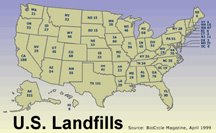Manager says Countywide is working hard to eliminate stink
The Times-Reporter
EAST SPARTA – Tim Vandersall, general manager of Countywide Recycling & Disposal Facility, vowed Thursday to win the hearts – and noses – of his downwind neighbors.
“We will meet the EPA director’s deadline,” he said while navigating the muddy paths that contour and weave through the slopes of the landfill’s mountainous trash piles.
The landfill near Bolivar has been the focus of complaints for months. Residents who reside within a few miles of the facility claim that the odor is nearly unbearable.
If the odor is not eliminated by Dec. 15 – the Ohio Environmental Protection Agency’s deadline to correct the problem – Vandersall said that the facility will continue to work until the problem is fixed.
“For people to say that we aren’t doing anything ... that’s just not the case,” he said.
“We’ve got people out here working hard every day. This is not something that we take lightly.”
Joseph Koncelik, director of the OEPA, declared the landfill in Stark County’s Pike Township a “public nuisance” in September after reviewing complaints from the Tuscarawas County commissioners, Lawrence Township trustees and the public in general.
Koncelik set the Dec. 15 deadline to eliminate the odors or Countywide will face additional actions, including fines and penalties.
Ironically, Vandersall’s one-story office building sits beside the waste cell that is the main source of the odors.
“We had an idea that we had an odor problem about this time last year,” he said, noting that he felt badly that area residents wound up being affected before Countywide could come up with a solution or track down the cause of the odor.
On Thursday, the front of the first 88 acres of the 170-acre landfill looked to be a combination of black dirt, mud, trash and large, unrolled sections of black tarp.
The tarps are a geo-membrane that eventually will cover 30 acres in some of the landfill’s older waste containment cells from which the odor still emanates. Occasionally piping from the landfill’s new gas well system poked though tarps. Some of the pipes were capped, others were not.
At spots, the strong odor was easily detectable.
A white, cherry-scented deodorizing spray plumed from the top of wooden poles, which held mesh fences, to the east of the landfill. Similar clouds could be seen coming from a tube draped along electric poles on the west side of the landfill nearest to I-77.
Vandersall said those plumes are part of Countywide’s deodorizing system, which increased from 40 to 323 spray nozzles within the last year.
“We’re still putting together our gas well and monitoring system, so some days we let off a little more odor than others,” he admitted. He said that problem would be corrected soon.
Eventually the collected gases will be burned off by large flares. Vandersall said a couple of flares can be seen from I-77 at night.
He said experts conducted several tests and determined an aluminum manufacturing bi-product called “dross,” also known as aluminum salt cake, had been reacting with water to cause the odors.
He said the chemical reaction when the salt cake came into contact with water led to a drop in one waste containment cell of about 30 feet within a year, noting the typical decomposition rate ranges between 5 feet and 10 feet.
“Aluminum dross isn’t considered a hazardous material,” he said, “but obviously we and the entire (waste disposal) industry had no idea about the risks associated with it. ...
“... There is a notion that we should just shut down to solve the problem. Closing Countywide would not solve a thing. We stopped accepting aluminum salt cake in 2001. The cells that have problems are old, and we are doing are best to address the odors.”
Some believe there’s a fire burning underneath the troubled waste cells.
“That’s just not true,” he said. “The chemical reaction does produce heat and gases, but there is no fire and the experts have not found ash or any other indicators of a fire.”
He said Countywide does not accept out-of-state waste, contrary to rumors.
“We heard complaints about trucks with New Jersey license plates coming through, but they were carrying in-state waste,” Vandersall said. “Apparently, there’s an advantage for truck drivers to get licensed elsewhere.”
Countywide takes waste from 25 counties in the northeast corner of Ohio. Most of the daily waste taken to the landfill comes from Stark, Tuscarawas and Wayne counties.
David Held, director of the Stark-Tuscarawas-Wayne Joint Solid Waste District, said he still is concerned despite Countywide’s efforts.
“We know the OEPA and Canton City Health Department are on top of this issue, and Countywide has been working cooperatively with everyone to resolve it,” he said from his Bolivar office Thursday.
“What we have are serious concerns with the subsidence, the gases being given off from chemical combustion and any leachate outbreaks that are occurring.”












